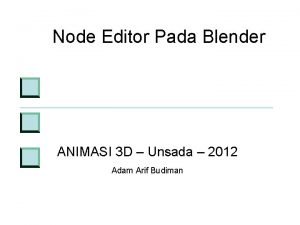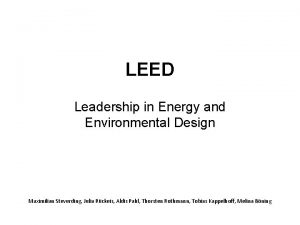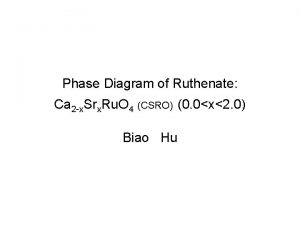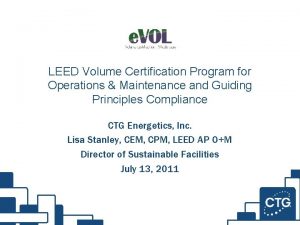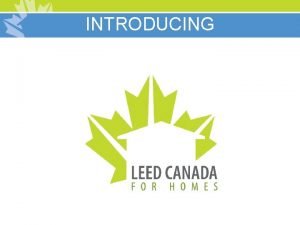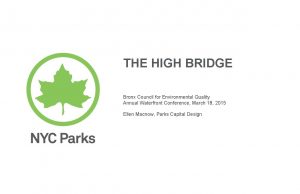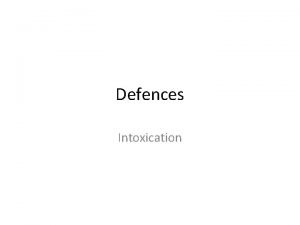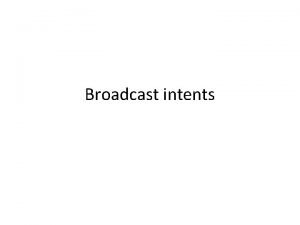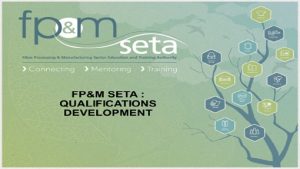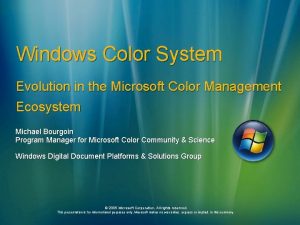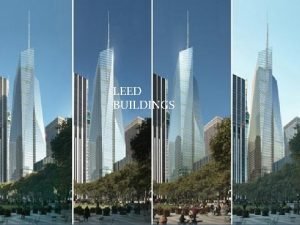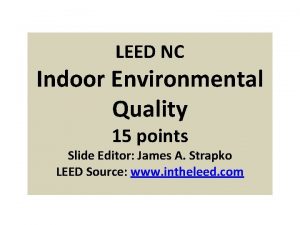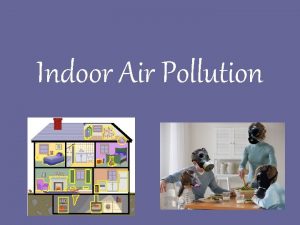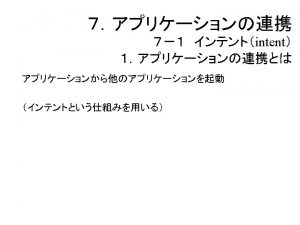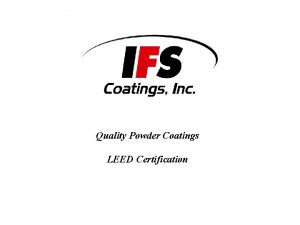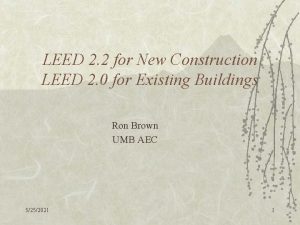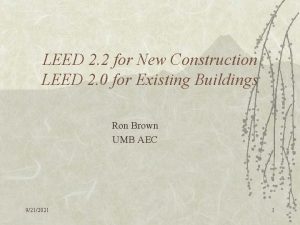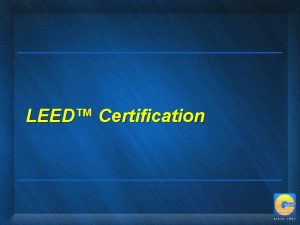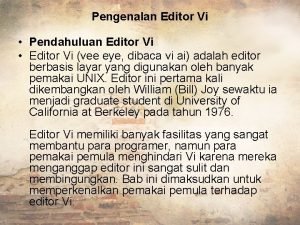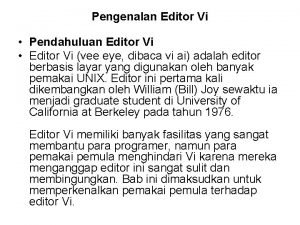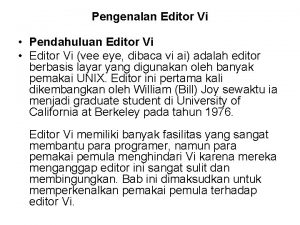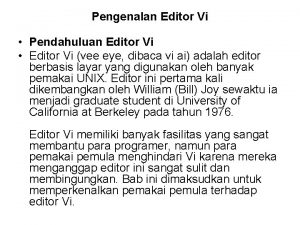LEED NC Indoor Environmental Quality INTENT Slide Editor










































- Slides: 42

LEED NC Indoor Environmental Quality INTENT Slide Editor: James A. Strapko LEED Source: www. intheleed. com

Indoor Environmental Quality 8 Credits; 15 Points EQPR 1: Minimum Indoor Air Quality EQPR 2: Environmental Tobacco Smoke (ETS) control EQc 1: Outdoor Air Delivery Monitoring EQc 2: Increase Ventilation EQc 3. 1: Construction IAQ Management, During Construction EQc 3. 2: Construction IAQ Management, Before Occupancy EQc 4. 1: Low-Emitting Materials, Adhesives & Sealants EQc 4. 2: Low-Emitting Materials, Paints & Coatings EQc 4. 3: Low-Emitting Materials, Carpet Systems EQc 4. 4: Low-Emitting Materials, Composite Wood & Agrifiber

Indoor Environmental Quality 8 Credits; 15 Points EQc 5: Indoor Chemical Pollutant Source Control EQc 6. 1: Controllability of Systems, Lighting EQc 6. 2: Controllability of Systems, Thermal Comfort EQc 7. 1: Thermal Comfort, Design EQc 7. 2: Thermal Comfort, Verification EQc 8. 1: Daylighting & Views, Daylight 75% of Spaces EQc 8. 2: Daylighting & Views, Daylight 90% of Spaces

EQ Prerequisite 1 Minimum Indoor Air Quality (IAQ) Performance

EQP 1: EQ Prerequisite 1 Minimum Indoor Air Quality (IAQ) Performance 1 st of 2 prerequisites in Indoor Environmental Air Quality (EQ for short) Intent: • to establish minimum IAQ performance to enhance indoor air quality in buildings • contribute to the well-being of the occupants Implementation: • Meet minimum requirement of Sections 4 thru 7 of ASHRAE 62. 1 -2004: Ventilation for Acceptable Indoor Air Quality Mechanical Ventilation Systems: • designed using Ventilation Rate procedure OR applicable local code (whichever is more stringent) Naturallly Ventilated buildings: comply with ASHRAE 62. 1 -2004. Code: • ASHRAE 62. 1 -2004: Ventilation for Acceptable Indoor Air Quality, Sections 4 thru 7 • Submittal Phase: • design

EQ Prerequisite 2 Environmental Tobacco Smoke (ETS) Control

EQP 2: EQ Prerequisite 2 Environmental Tobacco Smoke (ETS) Control Intent: Minimize exposure of building occupants, indoor surfaces, and ventilation systems to ETS (Environmental Tobacco Smoke). Implementation: • Option 1: Prohibit Smoking – no smoking except outdoors at least 25′-0” from: • entries • outside air intakes • operable windows • Option 2: Designated Areas – no smoking except in designated area and outdoor (same rules as previous for outdoor) – Designated smoke rooms to: • effectively capture, contain and remove ETS from building • be directly exhausted to outdoors • enclosed with deck to deck partitions • operate at negative pressure to adjacent spaces • Option 3 (residential only): No smoking in common areas. – no smoking in all building common areas – wall, ceiling and floor penetrations are to be sealed off – doors are to be weather stripped – be tested for performance (ASTM E 779 -03)

EQP 2: EQ Prerequisite 2 Environmental Tobacco Smoke (ETS) Control Code: • ANSI/ASTM E 779 -03, Standard Test Method for Determining Air Leakage Rate by Fan Pressurization • Residential Manual for Compliance with California’s 2001 Energy Efficiency Standards (For Low-Rise Residential Buildings), Chapter 4 Submittal Phase: • design

EQ Credit 1 Outdoor Air Delivery Monitoring

EQ Credit 1: 1 Point Outdoor Air Delivery Monitoring Intent: Provide capacity for ventilation system monitoring to sustain occupant comfort and wellbeing. Implementation: Install Permanent monitoring systems that provide feedback on ventilation system performance – systems to generate ALARM when conditions vary by 10% set point – Mechanically vented spaces: • Densely Monitored Space: > 25 people/1000 SF – monitor CO 2 levels » Monitor location to be 3′ to 6′ above floor finish • for non-densely occupied spaces – provide direct outdoor airflow measure device. – detect when system is 15% below design rate – Naturally Ventilated Space: • Monitor CO 2 – Monitor location to be 3′ to 6′ above floor finish – CO 2 and airflow measures by: • pilot tubes, venturi meters, rotating vane anemometers • feed into HVAC and BAS systems Code: none Submittal Phase: design

EQ Credit 2 Increase Ventilation

EQ Credit 2: 1 Point Increase Ventilation Intent: • Provide additional outdoor air ventilation to improve IAQ for improved occupant comfort, well-being of occupants and productivity. Implementation: • Mechanically Vented Spaces: – increase breathing zone outdoor air ventilation rates to 30% above minimum ASHRAE 62. 1 -2004 rates • Naturally Vented Spaces: – design system to meet Carbon Trust Good Practice Guide 237 (1998). – make sure ventilation is effective by flow diagram in Figure 1. 18 of CIBSE Application Manual 10: 2005 – use diagrammatic calculations to show design meets CIBSE or. . • use macroscopic, multi-zone, analytic mode to predict room-by-room airflows naturally ventilate 90% of occupied spaces per ASHRAE 62. 1 -2004 Codes: • ASHRAE 62. 1 -2004: Ventilation for Acceptable IAQ • Carbon Trust Good Practice Guide 237 (1998): Natural ventilation in non-domestic buildings • CIBSE Application Manual 10 (2005): Natural ventilation in non-domestic buildings Submittal Phase: design

EQ Credit 3. 1 Construction IAQ Management Plan - During Construction

EQ Credit 3. 1: 1 Point Construction IAQ Management Plan - During Construction Intent: • Reduce IAQ problems associated with Construction/Renovation process • Help to sustain comfort and well-being of construction workers and building occupants Implementation: • Develop and implement an Indoor Air Quality (IAQ) Management Plan for during construction – during construction, meet or exceed SMACNA IAQ Guidelines for Occupied Buildings Under Construction, Ch 3 (2007) – Protect on-site or installed absorptive materials from moisture damage • insulation, carpeting, ceiling tile and drywall – AHU’s, during construction, must have filters with Minimum Efficiency Reporting Value (MERV) of 8 per ASHRAE 52. 2 -1999. • Control pollutant sources – spec materials with low VOC’s – control exhaust fumes • Interrupt Contamination Pathways – depressurize work areas – provide temporary barriers

EQ Credit 3. 1: 1 Point Construction IAQ Management Plan - During Construction Implementation, continued: • Interrupt Contamination Pathways – depressurize work areas – provide temporary barriers • Housekeeping activities – protect porous surfaces – dust control • Schedule the installation of materials to avoid contamination • Member of General Contractor’s Team to be IAQ manager. Codes: • SMACNA IAQ Guidelines for Occupied Buildings Under Construction, Ch. 3 (2007) • ASHRAE 52. 2 -1999: Method of Testing General Ventilation Air-Cleaning Devices for Removal Efficiency by Particle Size Submittal Phase: • construction

EQ Credit 3. 2 Construction IAQ Management Plan - Before Occupancy

EQ Credit 3. 2: 1 Point Construction IAQ Management Plan - Before Occupancy Intent: • Reduce IAQ problems associated with Construction/Renovation process • Help to sustain comfort and well-being of construction workers and building occupants Implementation: • Develop and implement an Indoor Air Quality (IAQ) Management Plan for pre-occupancy phase Option 1: FLUSH-OUT • after construction but before occupancy • 14, 000 cubic feet of O/A (outside air) per sf of floor area • maintain 60 degrees • < 60% relative humidity • OR • if occupancy occur prior to flush out • delivery of 3500 cubic feet of O/A (outside air) per sf of floor area • ventilate at. 30 cfm/sf. • minimum 3 hours per date until 14, 000 cf/sf of O/A is delivered • USE MERV 13 filters for HVAC

EQ Credit 3. 2: 1 Point Construction IAQ Management Plan - Before Occupancy Option 2: Air Quality Testing • conduct an IAQ baseline test after construction, prior to occupancy • use EPA Compendium of Methods for the Determination of Air Pollutants in Indoor Air. Code: • EPA Compendium of Methods for the Determination of Air Pollutants in Indoor Air Submittal Phase: • construction

EQ Credit 4. 1 Low Emitting Materials Adhesives & Sealants

EQ Credit 4. 1: 1 Point Low Emitting Materials - Adhesives & Sealants Intent: • Reduce the quantity of indoor air contaminants that are odorous, irritating, and or harmful to the comfort and well-being of installers and occupants. Implementation: • all ADHESIVES and SEALANTS used in interior of building (inside weather proofing system & applied on-site) is to comply with South Coast Air Quality Management District (SCAQMD) Rule #1168 and Green Seal (GS) Standard for Commercial Adhesives GS-36. • flooring adhesives, fire-stopping sealants, caulking, duct sealants, plumbing adhesives, cove base adhesives. Code: • South Coast Air Quality Management District (SCAQMD) Rule #1168, October 3, 2003 Amendment • Green Seal Standard 36 (GS-36), Oct, 2000 Submittal Phase: • construction

EQ Credit 4. 2 Low Emitting Materials - Paints & Coatings

EQ Credit 4. 2: 1 Point Low Emitting Materials - Paints & Coatings Intent: • Reduce the quantity of indoor air contaminants that are odorous, irritating, and or harmful to the comfort and well-being of installers and occupants. Implementation: • all PAINT and COATINGS used in interior of building to comply with following: – PAINTS : Green Seal (GS) 11 – Anti-Corrosive and Anti-Rust Paints : GS-03 – Clear Wood Finishes, Floor Coatings, Stains, Sealers, Shellacs: SCAQMD Rule 1113 Code: • Green Seal Standard GS-11 • Green Seal Standard GS-03 • SCAQMD: South Coast Air Quality Management District Rule 1113, Architectural Coatings Submittal Phase: • construction

EQ Credit 4. 3 Low Emitting Materials - Carpet Systems

EQ Credit 4. 3: 1 Point Low Emitting Materials – Carpet Systems Intent: • Reduce the quantity of indoor air contaminants that are odorous, irritating, and or harmful to the comfort and well-being of installers and occupants. Implementation: • All CARPET and CARPET CUSHIONS installed in building interior shall meet testing and product requirement of the Carpet and Rug Institute’s Green Label Plus Program. • All carpet adhesives shall meet EQ 4. 1. Code: • Carpet and Rug Institute Green Label Plus Testing Program. Submittal Phase: • construction

EQ Credit 4. 4 Low Emitting Materials - Composite Wood & Agrifiber

EQ Credit 4. 4: 1 Point Low Emitting Materials - Composite Wood & Agrifiber Intent: • Reduce the quantity of indoor air contaminants that are odorous, irritating, and or harmful to the comfort and well-being of installers and occupants. Implementation: • Composite wood and Agrifiber products (MDF, particleboard, plywood, wheatboard, strawboard, panel substrates, door cores) used in interior of building shall contain NO ADDED UREA FORMALDEHYDE RESINS. Code: • none Submittal Phase: • construction

EQ Credit 5 Indoor Chemical and Pollutant Source Control

EQ Credit 5: 1 Point Indoor Chemical and Pollutant Source Control Intent: • Minimize potentially hazardous particulates and chemical pollutants. Implementation: • Minimize and control pollutant entry • Minimize Cross contamination between occupied areas • Install permanent entryway systems at least 6′-0" long to capture dirt – grates – grills • Exhaust rooms where hazardous chemicals are stored – keep negative pressure at. 50 cfm/sf • If Mechanically Vented , installed filters should have MERV 13 rating or better Codes: • ASHRAE 52. 2 -1999: Method of Testing General Ventilation Air Cleaning Devices for Removal Efficiency by Particle Size Submittal Phase: • design

EQ Credit 6. 1 Controllability of Systems - Lighting

EQ Credit 6. 1: 1 Point Controllability of Systems - Lighting Intent: • Provide high levels of lighting system control by individual occupants or multi-occupant spaces for various tasks for occupant’s comfort and well-being. Implementation: • Individual lighting controls for 90% minimum of building occupants • Multi-occupant lighting system controls that meet group needs and preferences Code: • none Submittal Phase: • design

EQ Credit 6. 2 Controllability of Systems - Thermal Comfort

EQ Credit 6. 2: 1 Point Controllability of Systems – Thermal Comfort Intent: • Provide high level of thermal comfort system control for individuals and multi-occupant spaces to promote productivity, comfort and well being of building occupants. Implementation: • Individual comfort controls for 50% min. of building occupants. • Operable windows are OK instead if: – occupants are stationed within 20′-0″ inside and 10′-0″ to either side of the window opening. – meets standards of ASHRAE 62. 1 -2004 for natural ventilation • Also provide thermal comfort controls for multi-occupancy rooms, adjustable to suit needs of various groups to occupy the space. – thermal comfort conditions under ASHRAE 55 -2004 Codes: • ASHRAE 62. 1 -2004: Ventilation for Acceptable Indoor Air Quality • ASHRAE 55 -2004: Thermal Environmental Conditions for Human Occupancy Submittal Phase: • design

EQ Credit 7. 1 Thermal Comfort - Design

EQ Credit 7. 1: 1 Point Thermal Comfort - Design Intent: • Provide a comfortable thermal environment supporting productivity and well-being of building occupants. Implementation: • Design HVAC systems and Building Envelope per ASHRAE 55 -2004. • Evaluate air temp. radiant temp, air speed, relative humidity • Coordinate with EQ P 1. EQ 1, & EQ 2. Code: • ASHRAE 55 -2004: Thermal Comfort Conditions for Human Occupancy Submittal Phase: • design

EQ Credit 7. 2 Thermal Comfort - Verification

EQ Credit 7. 2: 1 Point Thermal Comfort - Verification Intent: • Assessment of building’s thermal comfort over time. Implementation: • Survey within 6 -18 months after occupancy – anonymous responses of overall satisfaction of thermal performance • If 20% or more of building occupants dissatisfied, develop a plan for corrective action – Plan should be in accordance with ASHRAE 55 -2004 Code: • ASHRAE 55 -2004: Thermal Comfort Conditions for Human Occupancy Submittal Phase: • design

EQ Credit 8. 1 Daylighting and Views - Daylight 75% of Spaces

EQ Credit 8. 1: 1 Point Daylighting and Views - Daylight 75% of Spaces Intent: • Provide connection between indoor and outdoor spaces through introduction of daylight and views into regularly occupied areas of the building. Implementation: • OPTION 1 - GLAZING FACTOR CALCULATION – achieve min. 2% glazing factor in minimum of 75% of regularly occupied areas. • OPTION 2 - DAYLIGHT SIMULATION MODEL – through computer simulation, demonstrate min. daylight illumination level of 25 footcandles in min. of 75% of regularly occupied areas. • OPTION 3 - DAYLIGHT MEASUREMENT – through records of indoor light measurements, demonstrate daylight illumination level of 25 footcandles in min. of 75% of regularly occupied areas. • ALL CASES – only area associated with room (actual square footage) can be applied toward the 75% total area calculation – provide daylight redirection and/or glare control devices

EQ Credit 8. 1: 1 Point Daylighting and Views - Daylight 75% of Spaces Code: • none Extra Credit: • Provide daylighting for 90% (instead of 75%) of occupied areas. Submittal Phase: • design

EQ Credit 8. 2 Daylighting and Views - Daylight 90% of Spaces

EQ Credit 8. 2: 1 Point Daylighting and Views - Daylight 90% of Spaces Intent: • Provide connection between indoor and outdoor spaces through introduction of daylight and views into regularly occupied areas of the building. Implementation: • Achieve direct line of site to outdoor for occupants in 90% of all regularly occupied areas – glazing between 2′-6″ & 7′-6″ – Plan View: • area within sight lines drawing from perimeter vision glazing – Section View: • direct line of sight can be drawn from area to perimeter vision glazing Code: • none Extra Credit: • case by case basis Submittal Phase: • design

LEED NC Indoor Environmental Air Quality INTENT Slide Editor: James A. Strapko LEED Source: www. intheleed. com
 Implicit intent android studio
Implicit intent android studio Nodes in blender
Nodes in blender Heel toe polka steps
Heel toe polka steps Aldis pahl
Aldis pahl Leed for healthcare
Leed for healthcare Leed ga made easy
Leed ga made easy Leed
Leed Leed volume
Leed volume Leed canada for homes
Leed canada for homes Wireless health
Wireless health Edexcel controlled assessment
Edexcel controlled assessment Bronx council for environmental quality
Bronx council for environmental quality Completioness
Completioness How to facot
How to facot Quality assurance vs quality control
Quality assurance vs quality control Pmp quality management
Pmp quality management Pmp gold plating
Pmp gold plating Total quality management seminar
Total quality management seminar Compliance vs quality
Compliance vs quality Quality control concepts
Quality control concepts Quality gurus meaning
Quality gurus meaning Quality is free
Quality is free What is tqm
What is tqm Emory ras intent to submit
Emory ras intent to submit Always assume positive intent
Always assume positive intent Strategic fit vs strategic intent
Strategic fit vs strategic intent Mission vision
Mission vision Ndia intent guide
Ndia intent guide Opord sustainment paragraph
Opord sustainment paragraph Intent resolution
Intent resolution Intent to graduate form
Intent to graduate form Intoxication defence
Intoxication defence Creative intentions in drama
Creative intentions in drama Unusual letter formation
Unusual letter formation Android.intent.action.phone_state
Android.intent.action.phone_state Commander intent example
Commander intent example The deliberate intent to draw creative inspiration
The deliberate intent to draw creative inspiration Qcto letter of intent
Qcto letter of intent User intent modeling
User intent modeling Windowscolorsystem
Windowscolorsystem National letter of intent sample
National letter of intent sample Intentional fallacy meaning
Intentional fallacy meaning Intent.action_boot_completed
Intent.action_boot_completed

